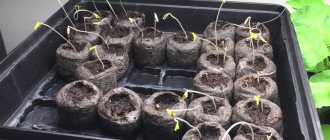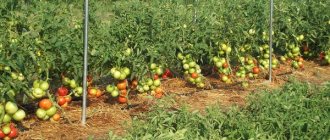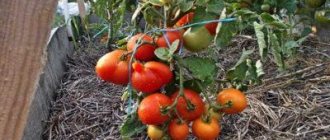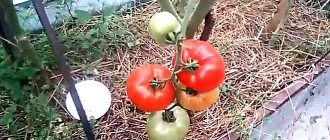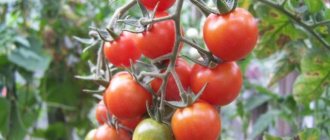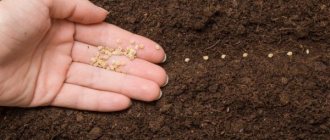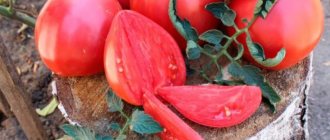Tomatoes are considered one of the most popular garden crops grown at home. Every gardener, both an experienced specialist and a beginner, dreams of growing a delicious red-sided, appetizing tomato. But if an avid gardener already knows how to make a dream come true by resorting to certain care for plantings, then a novice amateur needs to know when to properly loosen, form seedlings, feeding times and periods for proper watering. To ensure a rich harvest, it is important to know when and how to plant tomatoes as seedlings, which we will discuss in this article.
Time for sowing tomatoes for seedlings
Typically, seed manufacturers indicate on the packaging exactly when a particular variety should be sown. If there is no exact information, then pay attention to the ripening period of the fruit.
Latest articles about gardening
Seedlings without soil on toilet paper video
Seedlings for sale tips video
Pepper and tomato seedlings at home video
So, sow early-ripening tomatoes approximately 100-110 days before the expected harvest, of which about 7 days are for the emergence of seedlings. Sow seeds of mid-ripening varieties 120 days before, and late-ripening varieties – 130-140 days before the first fruits are harvested.
How to prepare soil in a greenhouse for planting tomatoes
It is highly undesirable to plant tomato seedlings in a greenhouse in the same soil for many years, since the soil tends to become very depleted and the vegetables begin to get sick. Therefore, there can be no talk of a rich harvest.
Before planting seedlings in the greenhouse, change the soil and spray it with a hot solution of copper sulfate in the following proportion: per 10 liters. water is added 1 tbsp. spoon of vitriol. 7 days before planting, beds are prepared (25-30 cm by 60-90 cm) with a passage of 60-70 cm.
Please note that the bed must be loosened, moistened and have good drainage.
Tomatoes prefer well-fertilized soil. To fertilize the soil, add natural ingredients: peat, sawdust, humus, taken in equal proportions. This mixture will be needed for 1 square. meter of greenhouse 3 buckets.
Preparing seeds and soil for planting tomatoes
Purchased and even homemade seeds cannot simply be “put into use”, since they require special preparation, which will increase productivity and protect vegetables from possible dangers. A similar approach applies to the soil where the tomato will be grown. Gardeners use several methods to prepare seeds for sowing, including soaking, germination, and dressing. According to practice, there is no significant difference between them. Experts recommend choosing seeds from well-known brands, because they rarely fail. Purchased material does not need to be treated against pathogens, since it is sold in ready-made form. If the seeds were collected on your own site, this practice makes sense.
Tomatoes often suffer from blackleg, and therefore before planting it is recommended to soak the seeds in a solution of potassium permanganate at a concentration of 3%. Then the seeds remain there for 3-5 hours and are then rinsed in clean water. Tomato seedlings are not demanding on the soil, are relatively resistant to drought and are not picky. It can also tolerate even high acidity. Under optimal conditions, tomatoes are resistant to dry substrate; if there is a lack of fertilizer, the sprouts should not die.
Sowing tomato seedlings
Tomatoes are supposed to be sown as seedlings, because they are southern heat-loving plants, and it is the seedling method of cultivation that allows you to get a harvest in a short summer. That’s why we plant tomatoes in the ground as seedlings, not seeds. Their further development and the harvest itself depend on how to plant tomato seedlings. An experienced vegetable grower who knows how to properly plant tomato seedlings first determines the sowing date, then skillfully selects and prepares planting material, as well as suitable dishes. The prepared soil is poured into containers and moistened using bottom watering. After the excess water has drained, small trenches less than 5 mm deep are made on the soil surface; it is convenient to do this with a ruler, so the rows are even. Seeds are placed in trenches in 2.5 cm increments and covered with earth. Leave 4 cm between trenches.
How to grow tomato seedlings at home with picking
Experienced gardeners already know all the intricacies of this difficult task. If you are at the beginning of your journey, then before you start growing, you need to find out in more detail what the success of the event depends on. Seeds in a beautiful package with a tempting description of the variety are far from a 100% guarantee of success. Although the choice of seeds is an important factor.
Light, temperature, soil, water and fertilizing are the most important things for growing seedlings.
It is believed that by the time of transplanting into the ground, tomato seedlings should look like this:
- height - 25-35 cm;
- stem thickness - 8-10 mm;
- real leaves - 7-10 pcs.;
- The first flower cluster is formed.
Temperature and light conditions for seedlings
Important factors for obtaining plants with such parameters are lighting and temperature conditions.
Immediately after sowing the seeds, the room should be warm, about 23-25 degrees, so that seedlings appear faster. As soon as the tomatoes begin to grow, for their normal development it is better to keep the room temperature at 18-22 degrees Celsius.
If the temperature in your room is higher, then it can be reduced by ventilation, but we must remember that young shoots are afraid of drafts.
Changes in one direction or another can have a negative impact on development:
- at temperatures above 25 degrees, the above-ground part of the shoots becomes thinner, the plants become thin and fragile. Leaves may turn yellow and fall off.
- at temperatures below 16 degrees, the growth of green mass slows down, but the root system actively develops.
- the lowest permissible temperature is 10 degrees Celsius, at which development stops, but the plants do not die. At lower temperatures they may die.
Another important factor is lighting. Tomatoes need 12-15 hours of daylight. The best option is if the windows in your house face south or southwest. But during the period when growing seedlings begins, the duration of daylight hours is too short and sometimes even the correct location of windows does not help.
When there is a lack of light in plants, the process of photosynthesis slows down, the stems begin to stretch, and elongated internodes appear on them. Elongated plants become weaker and more difficult to transport and plant in the ground.
Artificial lighting is a great way to maintain optimal light conditions.
But there is no need to overdo it in this matter either. Tomatoes need an overnight rest, which should be at least 5 hours. Therefore, round-the-clock lighting, as gardeners sometimes do, is not needed. During night rest, plants process what they accumulated during daylight hours. And if they are not allowed to rest, then over time a nutritional deficiency may begin.
Now the retail chain offers a variety of devices and lamps to organize lighting. It seems that it is quite difficult and expensive to arrange this in an apartment. Or maybe you shouldn’t get carried away with newfangled means. I suggest watching a video in which an experienced gardener offers a simple and inexpensive way to illuminate seedlings.
Preparing soil for growing tomato seedlings without a greenhouse
For active growth and development of the root system, young plants require fertile soil enriched with useful substances.
Many people harvest soil from their garden in the fall, but it is not recommended to use it in its pure form, as it is considered too “rough” for seedlings. Therefore, you can prepare the soil yourself by enriching the garden soil, or buy ready-made ones.
For example, look at several options for preparing an earthen mixture:
Humus and mullein can be replaced with purchased vermicompost. Vermiculite, perlite or coconut shavings can be used as a baking powder instead of sand.
When purchasing a ready-made mixture, you need to pay attention to the type of soil. There is a universal one, which is suitable for any plants, and there is a special one, designed for specific crops. Special soil is preferable, since it is prepared taking into account those components that are necessary for this type of plant.
But manufacturers are different, so when choosing, pay attention to some points:
- it is better to purchase soil from specialized stores and trusted manufacturers;
- if you do not have any preferences, then never buy products without a label;
- look at the composition, it should consist of several components, such as soil, peat, vermiculite, sand or other baking powder, mineral fertilizer, it is good if the composition includes vermicompost.
- the soil should be loose, slightly moist, but still flowable, non-sticky, without large lumps (if you come across small lumps, roots, fibers, sand, perlite particles, this is normal), there should be no smell of mold.
For example, look at what soil mixtures are available for sale and their composition.
The acidity of the soil is important and it should be close to neutral pH (6.5-6.7), since tomatoes do not develop well in an acidic environment. You can check it with a special device, litmus paper or using 9% table vinegar. You need to pour vinegar over the soil, pouring it onto the glass surface:
- alkaline soil will give strong foaming;
- neutral - weak;
- nothing will happen to acidic soil.
Soil acidity can be reduced using auxiliary substances:
- wood ash (1 tbsp per 1 kg of soil);
- chalk, dolomite flour or fluffed lime (2-3 tbsp per bucket of soil);
It is better to disinfect even high-quality soil before use. This helps clean the mixture from pathogenic bacteria, insect eggs, and protects against blackleg, a disease that often affects seedlings.
Known methods include steaming, freezing, and treatment with a manganese solution. But experts believe that such methods make the soil sterile and kill not only harmful, but also beneficial substances.
A simple and modern method is treatment with drugs that consist of beneficial bacterial cultures, suppress diseases, and increase plant immunity. Most often, Fitosporin is used, as well as drugs such as Planriz, Barrier, Extrasol and other fungicides. Before use, you should carefully study the instructions.
Sowing tomato seeds for seedlings in the ground (video with Oktyabrina Ganichkina)
Before sowing, it is necessary to select seeds, discard the bad ones, do pre-sowing treatment in order to disinfect the seeds and ultimately obtain strong, healthy seedlings.
Tomatoes love picking; this makes additional lateral roots develop better. This is a little stress for the plants and they stop their growth for some time, so the seedlings do not stretch as much as without picking.
If you plant tomatoes as seedlings with picking, then at the initial stage you do not need a deep container for planting. They use different containers, this can be a common container or separate cassettes (plastic cups) for each seed.
Whatever dish you choose, the main thing is that it can be filled with soil at least 5 centimeters thick. If you plant in a common container, the distance between the seeds should be 1.5-2 cm. Watch the video for more details.
Cover the planted seeds with a plastic lid or cover with cellophane and place in a warm place. If you plant different varieties, do not forget to label the containers with seeds indicating the name of the variety and the date of sowing, for subsequent control.
There is an opinion that melt water stimulates growth and experienced gardeners suggest covering them with snow immediately after sowing the seeds. Then put it in a cool place, and as soon as the snow melts, transfer it to a warm place.
Snail for planting seeds (step by step instructions)
Gardeners and gardeners come up with different ways to plant plants, and one of them is snail sowing. This method has become very popular because of its simplicity, it is convenient for those who do not have much space for seedlings, and the root system is not damaged during transplantation (unfold the snail and take out the plant).
What you will need:
- underlay for laminate of any color, 2 mm thick
- priming
- tape or rubber band for money
- container in which you will install the snail
- cellophane
How to do:
- Using a sharp knife, cut a strip 10 cm wide from the roll of substrate. The length can be any, depending on how many seeds you will plant.
- Place the tape on a flat surface, unwind a small part, moving 5 cm from the edge, pour 1-2 cm thick soil. Determine where you will have the top and bottom of the snail. You need to retreat 2 cm from the top and place the seeds in a row at a distance of 2 cm from each other.
- Once you fill this piece of tape, carefully so that the soil does not spill out, roll it into a roll. Next, we unwind the tape again and continue filling the snail until the seeds run out. Secure the structure with tape or rubber band.
- Place vertically in a plastic container with a small amount of water, without mixing up the bottom and top. Using a spray bottle, spray the top of the snail with water, cover with film and place in a warm place. When the sprouts appear, remove the film and care for it as for ordinary seedlings.
If you plant different varieties of tomatoes in one snail, you need to separate them with something, for example, with plastic knives, writing the name of the variety with a marker.
Video on how to plant tomato seeds in toilet paper
If you liked the method of planting in a snail, but there is no opportunity to purchase a substrate for the laminate, then gardeners are also resourceful here. Watch the video with detailed instructions.
How to care for tomato seedlings before picking
If you did everything correctly, then literally in a few days the first shoots will begin to appear. It is important not to miss this moment and as soon as the loops appear, you need to remove the film or remove the lid and place the seedlings in a bright but cooler place.
If you have organized lighting, then with the appearance of loops you need to provide round-the-clock lighting for 3-4 days, this will speed up their germination. Then switch to 12-15 hour illumination with a night rest break.
When the loops rise, at this stage you can select strong plants. It is believed that if the seed coat does not immediately come off the sprout, it means the plant is weak and it is recommended to remove it. High-quality sprouts should all be the same size; if some are very different (higher or lower), then they are also recommended to be removed. If you have a valuable variety and a limited amount of seeds, then such selection may not be done.
Watering is important for plants, but it should be moderate. Until the first true leaf appears, you need to monitor the soil; if it begins to dry out, then it should be slightly moistened with a spray bottle. After the true leaf appears, watering is carried out once a week. The leaves are still very tender, so try not to get water on them.
Watering, fertilizing, hardening of tomato seedlings after picking
Another important point for both plants and gardeners is picking seedlings. It is usually started 10-12 days after emergence and when there are 2-3 true leaves. At this stage, plants are also sorted and the strongest specimens are replanted.
The day before picking, you need to water the plants well to make it easier to remove the sprouts from the ground without damaging the weak roots.
Using a knife or spatula, carefully remove the sprout from the container and transplant it into another container of larger volume, deepening the tomato to the level of the cotyledons to form additional roots. Deep boxes for seedlings, plastic glasses with a capacity of 0.5 liters, cut-off milk and juice boxes or plastic bottles are used as containers.
In order for the plants to take root well, it is important that when planting there is no air gap between the soil and the roots, so when planting, you need to squeeze the soil well around the sprout.
After picking, water the tomatoes and leave to rest for a day in a cool place, only then send them under lighting. After 5 days, it is necessary to carry out the first fertilizing for the development of the root system.
To do this, prepare a solution a day before: 1 tbsp. l. superphosphate, pour 0.5 liters of boiling water, after a day add 1 tbsp. l. potassium sulfate. The seedlings are first watered and then fertilized at the rate of 2 tbsp. l. for 1 root.
You can use other complex fertilizers, the main thing is that they contain a high phosphorus content. This element is very important precisely at the early stage of plant development. It promotes root growth, earlier flowering, fruiting and increases the sugar content of fruits.
The next feeding is carried out after 10-14 days with complex fertilizers for seedlings. If the plants begin to stretch, then you need to choose a fertilizer with a low nitrogen content.
If, on the contrary, you see signs of nitrogen deficiency - small, yellowed leaves that may fall off, then feed with a high nitrogen content. But don’t get carried away with such fertilizers; from an excess of this element, the plants begin to fatten, and this significantly shifts the timing of fruiting.
If there is a lack of nitrogen, fertilizing with ammonia has worked well. Ammonia not only acts as a fertilizer, it protects seedlings from pests and pathogenic bacteria.
Prepare the solution as follows: dissolve 1-2 tsp in 1 liter of water. 10% ammonia solution. After watering, add 2 tbsp of solution. l. to the root.
Another fertilizing with complex fertilizers is recommended 10-12 days before planting the plants in the ground.
Excessive watering is another factor that causes tomato seedlings to become stretched, weakened, and may begin to hurt. Experts say that tomatoes tolerate soil drying out more easily than waterlogging.
Basic rules of watering:
- tomatoes do not like chlorine, so the water should be kept at room temperature;
- water the crop only at the roots, since wet leaves can burn in the bright sun;
- Tomatoes need to be watered little and rarely. The need for watering can be determined by the plants when their leaves droop slightly.
Hardening off seedlings is another important element of care and is needed in order to adapt them to the conditions in which they will have to grow in open ground (temperature changes, winds, rains).
You can start already with the appearance of the first true leaves. But since during this period plants need warmth to grow, hardening consists of keeping them briefly under an open window, thereby slightly reducing the temperature, the main thing is that there are no drafts.
The main hardening procedure begins 2 weeks before planting seedlings and involves keeping the plants at lower temperatures for some time. If possible, then take them outside; if you live in an apartment, then onto the balcony.
You need to start with short periods of time (2 hours a day), gradually increasing. If the seedlings tolerate the daytime drop in temperature well, then you can try leaving it for a short time in the evening, also gradually increasing it. Before planting, leave the tomato seedlings outside for 3 days, provided the weather is good.
It is important to monitor the plants at this time and not make mistakes:
- avoid drafts, do not leave in the rain or strong wind;
- if the plants suddenly droop, immediately bring them into the house;
- shade, protecting from ultraviolet rays;
- water only after bringing it into the house.
Picking tomato seedlings
Tomato picking is done when the seedling has two true leaf blades. To do this, soak the soil well and carefully remove one seedling at a time and transplant it into a separate container according to the root system. It is most convenient to do this at home or in an apartment.
When picking seedlings, you need to plant them quickly and carefully without interrupting the process, so as not to destroy the seedlings.
Planting tomato seedlings in open ground
The seedlings will be ready for planting when the first leaves appear on them. On average, at that time its size should be from 20 cm. It is not recommended to use long seedlings. This can lead to breaks and other problems.
Planting dates directly depend on weather conditions. The drier and warmer the spring, the better for vegetables. Typically, in our territories, planting is carried out from late April to early June. The planting itself should be carried out by making small holes in advance. Special solutions are poured into them or charcoal is added. Most often, solutions of fungicidal and potassium permanganate are suitable for such tomato bushes. Sometimes they make onion tincture. Chop the onion and garlic, mix with water, and let it brew.
Caring for tomatoes in open ground
Health, taste and yields certainly depend on the quality of care for tomatoes in the open field.
- Watering. To grow early ripening varieties, 4 times per season are enough: before planting, 7 days after planting, in early July and after the 20th. “Large-fruited plants” are usually watered every 2 days. It is permissible to dig through grooves along the row spacing. Only with settled warm water! The time of the “procedure” is always evening, carry out at the root. You can add ash or potassium permanganate.
- Hilling and loosening. Start hilling the tomato bushes a couple of weeks after the seedlings have rooted, then as needed. It is useful to loosen the soil after each watering.
- Maintaining taste. There should be enough light, heat (not hotter than 35), moderate moisture and phosphorus-potassium fertilizers, a little nitrogen.
- Garter. When growing ordinary varieties of tomatoes, 3-4 garters per season. Without pressing the brush with fruits.
Care after landing
Proper planting of any tomatoes is only the first step to getting a good harvest. In order for plants to develop, they need to be looked after. When the seedlings take root and begin to stretch upward, they need to be tied to a support. Sometimes combined cultivation of two crops is used. Corn is planted between the rows of tomatoes, then the bushes are tied to strong stalks of the cereal. This method is suitable for the southern regions. In the north, corn will shade out tomatoes.
After 2-3 weeks, the tomatoes are fertilized. To do this, 25 g of nitrogen, 40 g of phosphate and 15 g of potassium fertilizer are diluted in a bucket of water. 600-700 ml of solution is poured under each plant. You need to water the bushes as needed. Most often this is done 3-4 times a week. If it rains, reduce watering to once a week.
In order for tomatoes to ripen well, in the northern regions some of the leaves are removed from the bushes. In the south, this procedure is not done, since the foliage protects the fruits from the bright sun. It is important to monitor whether pests or fungi have appeared on the bushes. For prevention, preventive treatment of tomatoes is carried out with infusion of garlic, tobacco or fungicides. After harvesting, all tops are removed from the garden so as not to contaminate the soil. Before planting tomatoes in the same place another time, you need to maintain a three-year interval.
Prevention of tomatoes from diseases and pests
Growing tomatoes outdoors makes them especially vulnerable to common diseases and pests. Compliance with preventive measures will partially avoid problems.
- Maintain crop rotation, try not to plant tomatoes next to potatoes;
- Dig the soil well before planting and disinfect it;
- Plants affected by diseases or pests must be removed to protect healthy bushes;
- When watering, make sure that the drops do not fall on the leaves;
- Avoid watering during periods of severe temperature drop;
- Give preference to new varieties and hybrids that are resistant to common diseases;
- Use folk remedies to repel pests that damage plants and transmit diseases (infusion of garlic or onion).
Properly grown tomato seedlings quickly take root in the soil, form a strong green plant, begin to bloom and bear fruit within the time limits established for this variety.
When to plant tomatoes for seedlings
According to the generally accepted rule, sowing of a crop is carried out 55-65 days before its intended movement to a permanent planting site.
If we take into account that the deadline for seed germination is 5-10 days, then 1.5-2 months are allotted for its cultivation.
Based on the characteristics of the variety, you need to determine the deadline as accurately as possible. Overgrown seedlings do not take root well. As a result, productivity is greatly reduced.
Dates for sowing tomatoes in the regions
You can calculate the timing more accurately if you know when the threat of spring frosts has passed so that you can plant seedlings. Subtracting a couple of months from the expected date, we get the sowing date for open ground.
- Southern regions: from February 20 to March 15
- Central regions: from March 15 to April 1
- Northern regions: March 20 to April 5
For greenhouse varieties, the amendment is usually made for 2 weeks. These dates are approximate, since for a more accurate date it is necessary to take into account weather conditions.

